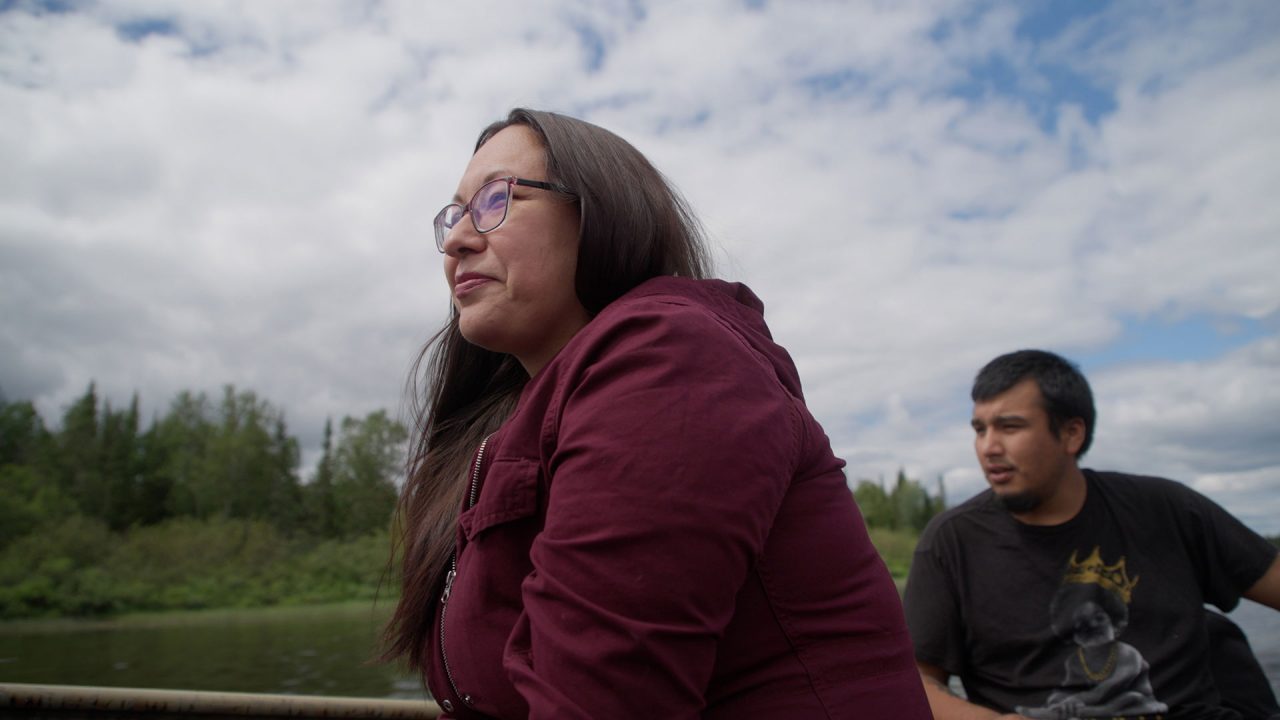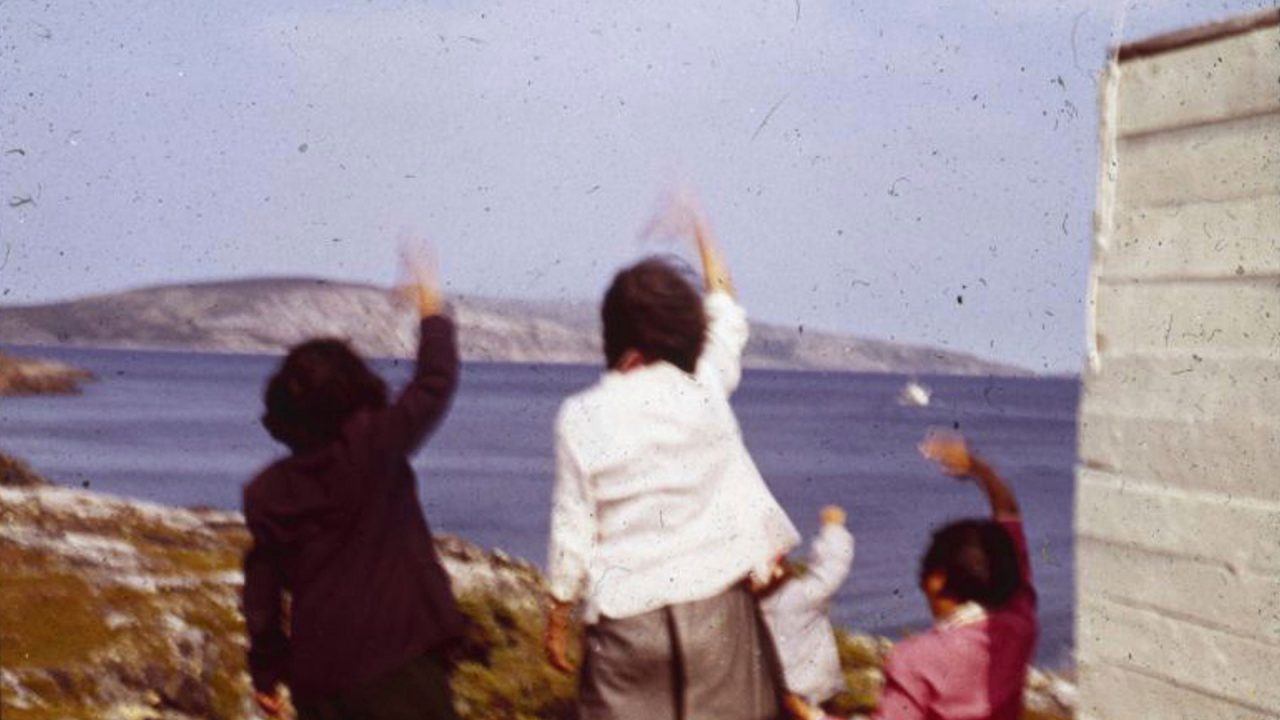
Mini-Lesson for Our Maternal Home and Stories Are in Our Bones
Mini-Lesson for Our Maternal Home and Stories Are in Our Bones
Mini-Lesson for Our Maternal Home and Stories Are in Our Bones
School Subjects:
- Indigenous Studies: Identity/Society, Issues and Contemporary Challenges
- Diversity/Pluralism: Identity
- Family Studies/Home Economics: Adolescent Development
- Geography: Territory: Indigenous
Ages: 15-17
Stories Are in Our Bones, Janine Windolph, provided by the National Film Board of Canada
Our Maternal Home, Janine Windolph, provided by the National Film Board of Canada
Educational Synopsis: Janine Windolph and her two urban-raised children, Corwyn and Dawlari of Waswanipi Cree First Nation, begin a healing journey that offers teachings about themselves, their culture and their history, thus shaping their identities as they grow. By connecting with their original ancestral homelands and Elders, Corwyn and Dawlari begin to develop experiential, traditional ecological knowledge, kinship connections and ways of life rooted in relationships with each other and the land. These connections guide them in establishing and maintaining a —shaping who they are, where they’re from and who they want to be as they move through life. During their journey, they practise acts of gratitude towards those they learn from, ancestors and the natural world. As Indigenous youth, they are supported and nurtured in the hope that they will create and maintain pathways rooted in a strong, loving foundation of cultural values.
Keywords/Topics: Identity, coming of age, land, reciprocity, ancestors, kinship, grandparents, traditions, sustainability, plants and medicines, intergenerational learning, food sustainability.
Overarching Question: How can connection to land, ancestors and acts of reciprocity influence who you are, your sense of belonging, your overall wellness and who you want to become?
Activity 1: Intergenerational learning: Spending time together on the land with Elders
Watch clip: Stories Are in Our Bones, 0:22–2:24
Guided Visualization: Visualize a serene lake, surrounded by lush green trees. Imagine the sounds of birds singing and a gentle breeze on your face.
Moment to Connect: Take a moment and imagine yourself sitting or spending time in this space with a grandparent, Elder or Knowledge Holder who has lived off the land.
In both films, the youth learn from Elders while on the land.
Silent Reflections:
- What does the filmmaker mean when she describes how kokum missed the land and how “being around her helps us see the world like our ancestors did”?
- Remember a time you were able to connect with a grandparent or imagine what that might be like. See yourselves together on your ancestral homelands while harvesting traditional food. Consider the following question: “Why is it so important for you to learn how to harvest traditional foods and what does it or could it mean to you to have been taught this skill by your grandmother?”
Group Share:
If possible, sit students in a circle and have them share their reflections aloud with the rest of the class. Move in a clockwise direction.
Summary:
Corwyn’s response: “I thought fishing looked fun and relaxing when watching family in La Ronge. And I thought providing fresh food for others is a pretty cool skill to have. And my kokum always said she would teach me. I was glad that we could bond over fishing.”
Intergenerational learning connects young people with grandparents and Elders and is a traditional cultural way of educating. The young learn from the old, and the old receive help and uplifting from the young. The relationship is reciprocal. A common way of learning within Nehiwayah (Cree) and most Indigenous traditional cultural practices includes land-based or experiential learning from Elders and the community. Learning through observing, doing and sharing stories deepens relationships with each other and builds knowledge. Methods of education such as language, stories, traditional gathering and preparation of food, connection to land and ceremony are all important in the healing, uplifting and flourishing of Indigenous Peoples. Many strategies of forced assimilation, including disconnection from land, language, kinship and cultural practices, continue to impact Indigenous Peoples across what is now called Canada. Janine, Corwyn and Dawlari begin their healing journeys through relationships with their Elders, community and ancestral homelands. The values they learn and practise through kinship bonds with people, the land and animals span urban and rural environments. Access to fresh food, providing for others, relaxing, enjoying time spent together and bonding all contribute to wellbeing, and can shape who you are and what you value.
Activity 2: Land as medicine
Watch clip: Our Maternal Home, 13:20–14:50
Focus Topics:
- Write the focus questions on eight large poster papers.
- Divide the class into eight focus groups.
- Each group takes 5–10 minutes to independently try to answer their focus question.
- Each group member then shares their answers verbally with their focus group and uses coloured markers to write keywords on the large poster paper.
- Rotate through the questions and have one or two people share answers with the larger group. Or place posters with answers and keywords on the walls, and students can do a gallery walk to see other participants’ questions and answers.
Focus Questions:
- Sometimes we don’t notice what is growing right around us, including plant medicines. For example, dandelions and plantain tend to grow in both urban and rural environments. What medicinal qualities do these plants have? What is Labrador tea and what are its medicinal properties?
- In the clip, we’re asked to “leave some for the bears.” How does this practice relate to sustainable harvesting?
- How do you or how can you connect with medicines growing on the land you’re surrounded by on a daily basis?
- How can harvesting traditional Indigenous plants and medicines contribute to wellbeing (emotional, mental, physical and spiritual) for individuals, and for society as a whole?
- In a holistic sense, how does harvesting Indigenous food and medicine from the land contribute to the health of human beings, as well as the plants and ecosystems themselves?
- What does relationality with the land and waters mean?
- How do the choices you make about what you consume, and how you consume it, impact who you are?
- What is Indigenous Food Sovereignty?
Summary:
Connecting and reconnecting with the land contributes to holistic health and wellness, physically, mentally, spiritually and emotionally. For example, fishing requires solitude, skill and patience, along with knowledge of the waters, time of day, techniques to use and the nutritional value of fish. Being outside and breathing in fresh clean air is also beneficial. All of this relates to health.
Many Indigenous plants, which have always grown on these lands and in these waters, are used for medicine, nourishment and ceremony. For example, Labrador tea is a medicine that many harvest respectfully. Offerings of gratitude to the land and sustainable picking are shown in these films. Disconnection from the land comes easily when we grow up depending on consumer products, instant gratification and easily prepared meals. Access to the process of harvesting and then consuming Indigenous traditional foods has become scarce. Medicines are not harvested from the territories for commercial gain. We must give great respect to the medicines of the territories. Practicing values such as patience while learning about Indigenous plants and medicines can help shape who you are and the choices you make in everyday life.
Activity 3: Reciprocity
Watch clips:
- Stories Are in Our Bones, 6:42–8:55
- Our Maternal Home, 9:10–9:30, 18:34–20:50, 23:30–24:34
Shoulder share with a partner or create a visual thinking map to show your thoughts:
- What is reciprocity?
- How is the process of creating the feast an act of reciprocity?
- What forms of reciprocity are expressed in your traditional ancestral homelands and culture? Or, if this is hard to access, can you imagine where and how some of your distant ancestors might have lived?
Summary:
Cultural practices of reciprocity were featured in the film. Reciprocity includes acknowledging and being thankful for reciprocal relationships among one another and the natural world. In Our Maternal Home, gratitude is given to the water in the form of thanks and acknowledgment of the gifts it brings. The offering of tobacco is also shown in both films. Tobacco is held sacred to Nehiwayah (Cree) and many First Nations. It is offered to the land as a form of gratitude for providing, and to people like Elders and Knowledge Holders when knowledge, prayers and spiritual guidance are sought.
Feasting is also an act of reciprocity. Reciprocity was reflected in all aspects of the feast’s preparation. A Nehiwayah (Cree) cultural practice of reciprocity involves offering a plate of food, called a spirit plate, with tobacco on the side. The plate is offered to a fire along with prayer. This is done to acknowledge, offer gratitude and feed the spirits of ancestors who have passed. Hands-on learning, relationship-building, kinship bonds, stories, healing and gratitude for each other and the land are all part of feasting.
Take Action: Coming of Age
Using a communication style of choice (e.g., a video, collage, art piece, poem, visual map, song or essay), respond to the following:
Choose one of the film titles (Stories Are in Our Bones or Our Maternal Home) and reflect on how the film’s title and themes relate, and how they resonate with you. Answer the question, “How can developing and strengthening the connection to your original ancestral homelands and ancestry influence who you are, your sense of belonging, your wellness and who you want to be in this world?”
Summary:
The title Stories Are in Our Bones reflects the film’s theme of how identity is shaped and embodied in each person. Stories of our ancestors and their experiences, worldview and culture are passed on to each new generation directly and indirectly. Indirectly, we can connect through our senses—like when we eat food, an act that is passed down through the generations. Our senses become a key part of how we experience and find a connection to our ancestors. The stories we experience firsthand, like connecting with the land and family, are then passed onto future generations. The stories, if we listen, help shape the paths we take in life.
The title Our Maternal Home reflects a Nehiwayah way of life that connects us with our mothers and Mother Earth. The land and our mothers, aunties and sisters all nourish and shape our identities. The title also reflects the relationship to land, Mother Earth, as a matriarchal figure, and how the land sustains and nourishes plants, animals and people. Identity is often associated with the matrilineal line in connection to family history and culture, and with returning to the teachings of the land.
Crystal Clark is a Cree/Dene Métis mother, Educator, Indigenous Education Consultant, and artist who is dedicated to supporting the Calls to Action. She has a background in New Media studies at the Vancouver Film School, a Bachelor of Education, a fine arts degree and a master’s degree in Educational Technology, as well as an Indigenous Creative Writing and Visual Arts diploma from the En’okin Center. She also has extensive experience teaching in First Nations communities, and experience in resource development, research and the facilitation of Indigenous Education for teachers across the province of Alberta, as well as in teaching educational technology to pre-service teachers.
Pour lire cet article en français, cliquez ici.
Discover more Mini-Lessons | Watch educational films on NFB Education | Watch educational playlists on NFB Education | Follow NFB Education on Facebook | Follow NFB Education on Pinterest | Subscribe to the NFB Education Newsletter



